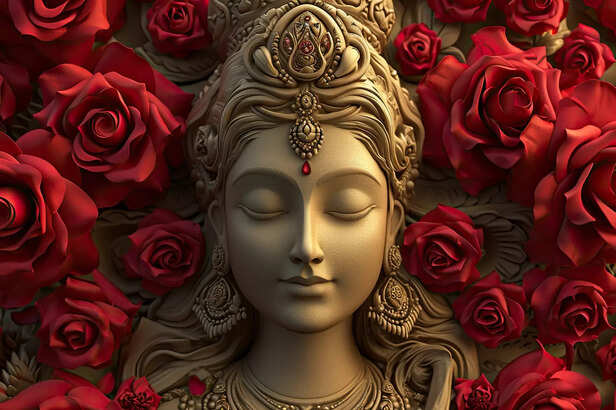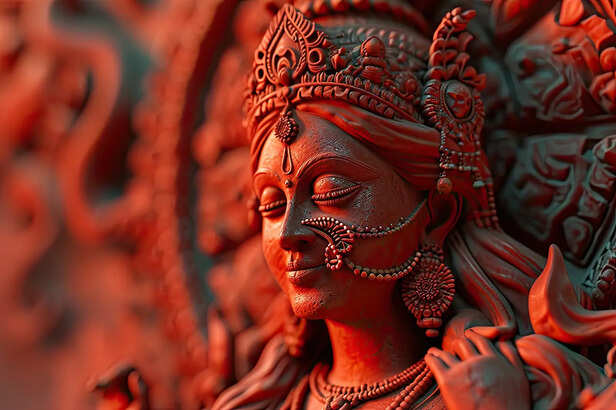Aditi: The Forgotten Cosmic Mother of Hindu Mythology
Ushnish Samadder | Freepik | Jul 03, 2025, 20:44 IST
Aditi
( Image credit : Freepik )
In the vast constellation of Hindu deities, where powerful gods like Vishnu, Shiva, and Shakti dominate stories and scriptures, one ancient figure quietly radiates immense cosmic importance—Aditi, the Mother of the Gods. While she may not be a household name in modern Hindu practice, her influence permeates the earliest Vedic hymns and underpins the foundations of Hindu cosmology.
Aditi is more than a mythological mother—she is a cosmic force, the infinite expanse from which all life emerges. In an age when ancient wisdom is being rediscovered and recontextualized, it is time to reintroduce the world to this timeless goddess of freedom, space, and universal compassion.
![Goddess]()
In Sanskrit, Aditi means "limitless", "unbounded", or "freedom." She first appears in the Rigveda (circa 1500–1200 BCE), one of the oldest known spiritual texts, where she is described as the mother of the Adityas—a group of celestial deities who uphold ṛta, the cosmic order.
Unlike many Hindu goddesses associated with specific domains (wealth, war, learning), Aditi is more abstract and universal. She represents:
According to Vedic cosmology, Aditi is not just the mother of the gods—she is the first cause, the matrix from which even time, space, and law arise.
The Divine Duality:
![Hinduism]()
In many myths, Aditi’s story is juxtaposed with that of her sister Diti, who is regarded as the mother of the Daityas (often called asuras, or demons). The children of Aditi, the Devas, represent order, clarity, and light, while Diti’s offspring embody chaos, ego, and darkness.
This duality is not moralistic in the Western sense. In Hindu philosophy, Devas and Asuras are cosmic forces—both necessary to the cycle of creation, destruction, and rebirth. However, Aditi is seen as the embodiment of balance, restraint, and higher consciousness, whereas Diti represents the disruptive energies of desire and attachment.
This eternal interplay between Aditi and Diti reflects the core philosophical principle of duality in the universe—where light and darkness, order and chaos, are in constant dynamic tension.
One of the most memorable stories featuring Aditi appears in the Bhagavata Purana. In this tale, the demon king Mahabali defeats the gods and takes control of the three worlds. Grieved by her children’s loss and the suffering of the righteous, Aditi undertakes severe penance to invoke Lord Vishnu.
Pleased by her devotion, Vishnu is born as her son in the form of Vamana, a dwarf Brahmin. Disguised and humble, Vamana visits Mahabali and requests just three paces of land. Once granted, he grows to cosmic proportions and reclaims the universe in three strides—restoring the balance between good and evil.
This tale is not only a showcase of divine intervention, but also of Aditi’s pivotal role in the restoration of cosmic order. Her maternal love, spiritual dedication, and strength catalyze one of Vishnu’s most famous incarnations.
Despite her vital importance in early Vedic thought, Aditi does not feature prominently in mainstream Hindu worship today. She has:
Aditi, by contrast, remains a transcendental and cosmic figure, harder to personify or contain within idol-based rituals. But her influence is deep, woven through the theological and cosmological roots of Hinduism.
Aditi in Contemporary Thought
![Goddess Aditi]()
Today, scholars, feminists, and spiritual seekers are rediscovering Aditi as a symbol of divine femininity, cosmic motherhood, and spiritual liberation.
“She represents the infinite,” says Dr. Anjali Sharma, a Vedic studies scholar. “Before time, before names, before even the gods themselves—there is Aditi. She is the root of sacred motherhood, freedom, and expansive consciousness.”
In feminist theology, Aditi is seen as a pre-patriarchal goddess, existing before the rise of male-dominated pantheons. Her role as the origin of gods places her in line with Great Mother figures from other ancient cultures—such as Gaia (Greek), Nut (Egyptian), and Nammu (Sumerian).
Her gendered cosmic symbolism—as both mother and space—also makes Aditi an important figure for ecological and spiritual frameworks that connect the Earth and cosmos through the nurturing feminine.
In a time marked by polarization, conflict, and spiritual searching, Aditi offers a unifying principle. She represents:
Though largely forgotten in ritual practice, Aditi’s presence endures—in the verses of the Rigveda, the tales of the Puranas, and the collective memory of Hindu philosophy.
She is not just a mother of gods, but the mother of cosmic order, infinite freedom, and divine possibility. As the world rediscovers ancient wisdom in the face of modern chaos, Aditi waits quietly, her arms open as wide as the sky.
Explore the latest trends and tips in Health & Fitness, Travel, Life Hacks, Fashion & Beauty, and Relationships at Times Life!
Who Is Aditi?

Goddess
( Image credit : Freepik )
In Sanskrit, Aditi means "limitless", "unbounded", or "freedom." She first appears in the Rigveda (circa 1500–1200 BCE), one of the oldest known spiritual texts, where she is described as the mother of the Adityas—a group of celestial deities who uphold ṛta, the cosmic order.
These Adityas include:
- Varuna – God of cosmic law and oceans
- Mitra – Deity of harmony, friendship, and contracts
- Aryaman – Patron of societal customs and hospitality
- Bhaga – God of wealth and fortune
- Ansha, Dhata, Tvashta, and Vivasvat (the solar deity)
- Indra – King of the gods (in some traditions)
Aditi as a Cosmic Symbol
- The primordial womb of creation
- The sky, vast and limitless
- Eternal freedom from bondage, sin, or ignorance
- The foundation of all being
According to Vedic cosmology, Aditi is not just the mother of the gods—she is the first cause, the matrix from which even time, space, and law arise.
The Divine Duality: Aditi and Diti

Hinduism
( Image credit : Freepik )
In many myths, Aditi’s story is juxtaposed with that of her sister Diti, who is regarded as the mother of the Daityas (often called asuras, or demons). The children of Aditi, the Devas, represent order, clarity, and light, while Diti’s offspring embody chaos, ego, and darkness.
This duality is not moralistic in the Western sense. In Hindu philosophy, Devas and Asuras are cosmic forces—both necessary to the cycle of creation, destruction, and rebirth. However, Aditi is seen as the embodiment of balance, restraint, and higher consciousness, whereas Diti represents the disruptive energies of desire and attachment.
This eternal interplay between Aditi and Diti reflects the core philosophical principle of duality in the universe—where light and darkness, order and chaos, are in constant dynamic tension.
Aditi and the Vamana Avatar: A Mother’s Devotion
Pleased by her devotion, Vishnu is born as her son in the form of Vamana, a dwarf Brahmin. Disguised and humble, Vamana visits Mahabali and requests just three paces of land. Once granted, he grows to cosmic proportions and reclaims the universe in three strides—restoring the balance between good and evil.
This tale is not only a showcase of divine intervention, but also of Aditi’s pivotal role in the restoration of cosmic order. Her maternal love, spiritual dedication, and strength catalyze one of Vishnu’s most famous incarnations.
Why Isn’t Aditi Widely Worshipped Today?
- No major temples dedicated to her
- Few if any festivals held in her name
- A primarily philosophical presence rather than ritual or iconographic
Aditi, by contrast, remains a transcendental and cosmic figure, harder to personify or contain within idol-based rituals. But her influence is deep, woven through the theological and cosmological roots of Hinduism.
Aditi in Contemporary Thought

Goddess Aditi
( Image credit : Freepik )
Today, scholars, feminists, and spiritual seekers are rediscovering Aditi as a symbol of divine femininity, cosmic motherhood, and spiritual liberation.
“She represents the infinite,” says Dr. Anjali Sharma, a Vedic studies scholar. “Before time, before names, before even the gods themselves—there is Aditi. She is the root of sacred motherhood, freedom, and expansive consciousness.”
In feminist theology, Aditi is seen as a pre-patriarchal goddess, existing before the rise of male-dominated pantheons. Her role as the origin of gods places her in line with Great Mother figures from other ancient cultures—such as Gaia (Greek), Nut (Egyptian), and Nammu (Sumerian).
Her gendered cosmic symbolism—as both mother and space—also makes Aditi an important figure for ecological and spiritual frameworks that connect the Earth and cosmos through the nurturing feminine.
Aditi’s Message for a Modern World
- Freedom from divisions—political, religious, or personal
- Boundless compassion and forgiveness
- The infinite potential within all beings
Though largely forgotten in ritual practice, Aditi’s presence endures—in the verses of the Rigveda, the tales of the Puranas, and the collective memory of Hindu philosophy.
She is not just a mother of gods, but the mother of cosmic order, infinite freedom, and divine possibility. As the world rediscovers ancient wisdom in the face of modern chaos, Aditi waits quietly, her arms open as wide as the sky.
Explore the latest trends and tips in Health & Fitness, Travel, Life Hacks, Fashion & Beauty, and Relationships at Times Life!
